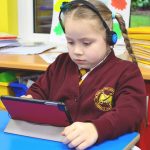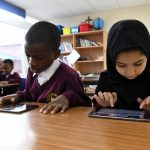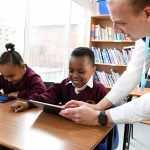Intent
At SS Peter and Paul, the pupils experience a rich, deep learning experience that balances all the aspects of computing – computer science, digital literacy and information technology. With technology playing such a significant role in society today, we believe our children must be familiar with all aspects of computing so that they are to be able to participate effectively and safely in this digital world – celebrating safer internet day within a planned E-safety focus across a half term ensures that our pupil’s needs in this area are met.
A high-quality computing education equips our pupils to aspire to use creativity to understand and change the world. Computing has intra-curricular links with mathematics, science, and design and technology, and these are interwoven throughout the curriculum.
During their time at SS Peter and Paul, the pupils are introduced to a wide range of technology, including chromebooks, iPads, micro:bits and interactive whiteboards, allowing them to continually practice, build on and transfer their skills to improve their knowledge. This ensures they become digitally literate so that they are able to express themselves and develop their ideas through information and computer technology– at a level suitable for the future workplace and as active participants in a digital world.
We teach a sequenced and progressive curriculum that enables children to become effective users of technology who can: Understand and apply the essential principles and concepts of Computer Science, including logic, algorithms and data representation.
This curriculum is reviewed regularly to assess the impact it has on our pupils, adapting where necessary to help our children achieve and be successful.
Implementation
Our Computing curriculum is split into three main areas: Digital Literacy (DT), Computer Science (CS) and Information Technology (IT). These areas are taught over a term within each year group using a range of computing devices including chromebooks and iPads so our children become digitally literate with both devices. Specified apps and programs are used on these devices to ensure that the national curriculum objectives for Computing are met. Staff are guided on which apps,programs to use through our Computing long term plan and the skills that the children will acquire through the progression of skills document.
Our Computing curriculum is also designed to be flexible, so children can apply their learnt skills into other areas of the curriculum during our Wider Curriculum weeks and showcase their computing skills in other lessons via a QR code link. Computing is timetabled weekly, with all children having regular access to their required resources. This provides opportunities for children to reactivate their learning and help knowledge embed into their long term memory.
Children are provided with their own ‘Google Suite’ usernames which enables the children to further their learning at home, able to sign in across several devices, sharing their computing work at home. Homework is also set via Google Classroom, supporting our computing curriculum and enabling the children to embed their skills learnt through regular practise.
Impact
Through the delivery of our Computing curriculum, the children are computer literate and well-prepared for their next step in education. Children enjoy computing and the range of skills that they are taught, along with that deeper understanding of how these skills can support them in later life. Their learning will build on prior knowledge and understanding, supporting the children in being successful. Most importantly, the children have a very clear understanding of what it means to be safe online, how to report anything they feel isn’t right and think about their digital footprint for the future.
Documents
- Computing - Progression.pdf pdf944.2 KbJun 7th, 2022
- Computing LTP 23-24.pdf pdf462.1 KbSep 7th, 2023
- Computing MTP - Year 1 .pdf pdf979.6 KbSep 24th, 2022
- Computing MTP - Year 2 .pdf pdf976.1 KbSep 24th, 2022
- Computing MTP - Year 3 .pdf pdf974.6 KbSep 24th, 2022
- Computing MTP - Year 4.pdf pdf974.8 KbSep 24th, 2022
- Computing MTP - Year 5.pdf pdf977.7 KbSep 24th, 2022
- Computing MTP - Year 6.pdf pdf980.9 KbSep 24th, 2022




